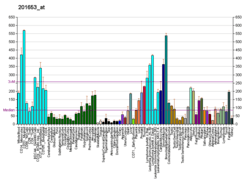Protein cornichon homolog is a protein that in humans is encoded by the CNIH gene.[5][6]
References
- 1 2 3 GRCh38: Ensembl release 89: ENSG00000100528 - Ensembl, May 2017
- 1 2 3 GRCm38: Ensembl release 89: ENSMUSG00000015759 - Ensembl, May 2017
- ↑ "Human PubMed Reference:".
- ↑ "Mouse PubMed Reference:".
- ↑ Utku N, Bulwin GC, Beinke S, Heinemann T, Beato F, Randall J, Schnieders B, Sandhoff K, Volk HD, Milford E, Gullans SR (May 1999). "The human homolog of Drosophila cornichon protein is differentially expressed in alloactivated T-cells". Biochim Biophys Acta. 1449 (3): 203–10. doi:10.1016/S0167-4889(99)00026-9. PMID 10209299.
- ↑ "Entrez Gene: CNIH cornichon homolog (Drosophila)".
Further reading
- Castro CP, Piscopo D, Nakagawa T, Derynck R (2007). "Cornichon regulates transport and secretion of TGFalpha-related proteins in metazoan cells". J. Cell Sci. 120 (Pt 14): 2454–66. doi:10.1242/jcs.004200. PMID 17607000.
- Otsuki T, Ota T, Nishikawa T, et al. (2007). "Signal sequence and keyword trap in silico for selection of full-length human cDNAs encoding secretion or membrane proteins from oligo-capped cDNA libraries". DNA Res. 12 (2): 117–26. doi:10.1093/dnares/12.2.117. PMID 16303743.
- Gerhard DS, Wagner L, Feingold EA, et al. (2004). "The Status, Quality, and Expansion of the NIH Full-Length cDNA Project: The Mammalian Gene Collection (MGC)". Genome Res. 14 (10B): 2121–7. doi:10.1101/gr.2596504. PMC 528928. PMID 15489334.
- Clark HF, Gurney AL, Abaya E, et al. (2003). "The Secreted Protein Discovery Initiative (SPDI), a Large-Scale Effort to Identify Novel Human Secreted and Transmembrane Proteins: A Bioinformatics Assessment". Genome Res. 13 (10): 2265–70. doi:10.1101/gr.1293003. PMC 403697. PMID 12975309.
- Strausberg RL, Feingold EA, Grouse LH, et al. (2003). "Generation and initial analysis of more than 15,000 full-length human and mouse cDNA sequences". Proc. Natl. Acad. Sci. U.S.A. 99 (26): 16899–903. doi:10.1073/pnas.242603899. PMC 139241. PMID 12477932.
- Zhang QH, Ye M, Wu XY, et al. (2001). "Cloning and Functional Analysis of cDNAs with Open Reading Frames for 300 Previously Undefined Genes Expressed in CD34+ Hematopoietic Stem/Progenitor Cells". Genome Res. 10 (10): 1546–60. doi:10.1101/gr.140200. PMC 310934. PMID 11042152.




